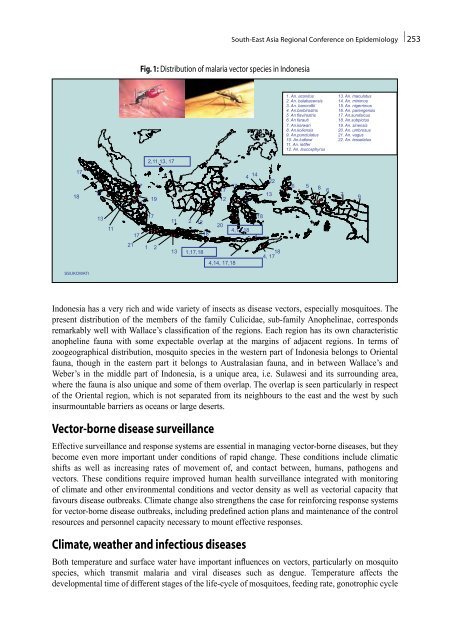South-East Asia Regional Conference on Epidemiology
South-East Asia Regional Conference on Epidemiology
South-East Asia Regional Conference on Epidemiology
You also want an ePaper? Increase the reach of your titles
YUMPU automatically turns print PDFs into web optimized ePapers that Google loves.
Fig. 1: Distributi<strong>on</strong> of malaria vector species in Ind<strong>on</strong>esia<br />
<str<strong>on</strong>g>South</str<strong>on</strong>g>-<str<strong>on</strong>g>East</str<strong>on</strong>g> <str<strong>on</strong>g>Asia</str<strong>on</strong>g> <str<strong>on</strong>g>Regi<strong>on</strong>al</str<strong>on</strong>g> <str<strong>on</strong>g>C<strong>on</strong>ference</str<strong>on</strong>g> <strong>on</strong> <strong>Epidemiology</strong> | 253<br />
Ind<strong>on</strong>esia has a very rich and wide variety of insects as disease vectors, especially mosquitoes. The<br />
present distributi<strong>on</strong> of the members of the family Culicidae, sub-family Anophelinae, corresp<strong>on</strong>ds<br />
remarkably well with Wallace’s classificati<strong>on</strong> of the regi<strong>on</strong>s. Each regi<strong>on</strong> has its own characteristic<br />
anopheline fauna with some expectable overlap at the margins of adjacent regi<strong>on</strong>s. In terms of<br />
zoogeographical distributi<strong>on</strong>, mosquito species in the western part of Ind<strong>on</strong>esia bel<strong>on</strong>gs to Oriental<br />
fauna, though in the eastern part it bel<strong>on</strong>gs to Australasian fauna, and in between Wallace’s and<br />
Weber’s in the middle part of Ind<strong>on</strong>esia, is a unique area, i.e. Sulawesi and its surrounding area,<br />
where the fauna is also unique and some of them overlap. The overlap is seen particularly in respect<br />
of the Oriental regi<strong>on</strong>, which is not separated from its neighbours to the east and the west by such<br />
insurmountable barriers as oceans or large deserts.<br />
Vector-borne disease surveillance<br />
Effective surveillance and resp<strong>on</strong>se systems are essential in managing vector-borne diseases, but they<br />
become even more important under c<strong>on</strong>diti<strong>on</strong>s of rapid change. These c<strong>on</strong>diti<strong>on</strong>s include climatic<br />
shifts as well as increasing rates of movement of, and c<strong>on</strong>tact between, humans, pathogens and<br />
vectors. These c<strong>on</strong>diti<strong>on</strong>s require improved human health surveillance integrated with m<strong>on</strong>itoring<br />
of climate and other envir<strong>on</strong>mental c<strong>on</strong>diti<strong>on</strong>s and vector density as well as vectorial capacity that<br />
favours disease outbreaks. Climate change also strengthens the case for reinforcing resp<strong>on</strong>se systems<br />
for vector-borne disease outbreaks, including predefined acti<strong>on</strong> plans and maintenance of the c<strong>on</strong>trol<br />
resources and pers<strong>on</strong>nel capacity necessary to mount effective resp<strong>on</strong>ses.<br />
Climate, weather and infectious diseases<br />
Both temperature and surface water have important influences <strong>on</strong> vectors, particularly <strong>on</strong> mosquito<br />
species, which transmit malaria and viral diseases such as dengue. Temperature affects the<br />
developmental time of different stages of the life-cycle of mosquitoes, feeding rate, g<strong>on</strong>otrophic cycle









